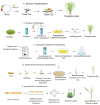Exosome/Liposome-like Nanoparticles: New Carriers for CRISPR Genome Editing in Plants
- PMID: 34299081
- PMCID: PMC8304373
- DOI: 10.3390/ijms22147456
Exosome/Liposome-like Nanoparticles: New Carriers for CRISPR Genome Editing in Plants
Abstract
Rapid developments in the field of plant genome editing using clustered regularly interspaced short palindromic repeats (CRISPR)/CRISPR-associated protein (Cas) systems necessitate more detailed consideration of the delivery of the CRISPR system into plants. Successful and safe editing of plant genomes is partly based on efficient delivery of the CRISPR system. Along with the use of plasmids and viral vectors as cargo material for genome editing, non-viral vectors have also been considered for delivery purposes. These non-viral vectors can be made of a variety of materials, including inorganic nanoparticles, carbon nanotubes, liposomes, and protein- and peptide-based nanoparticles, as well as nanoscale polymeric materials. They have a decreased immune response, an advantage over viral vectors, and offer additional flexibility in their design, allowing them to be functionalized and targeted to specific sites in a biological system with low cytotoxicity. This review is dedicated to describing the delivery methods of CRISPR system into plants with emphasis on the use of non-viral vectors.
Keywords: CRISPR; exosomes and liposomes; genome editing; nanoparticles.
Conflict of interest statement
The authors declare no conflict of interest.
Figures



References
-
- Demirer G.S., Chang R., Zhang H., Chio L., Landry M.P. Nanoparticle-Guided Biomolecule Delivery for Transgene Expression and Gene Silencing in Mature Plants. BioRxiv. 2017:179549. doi: 10.1016/j.bpj.2017.11.1209. - DOI
-
- Rai M., Bansod S., Bawaskar M., Gade A., Dos Santos C.A., Seabra A.B., Duran N. Nanotechnologies in Food and Agriculture. Springer; Cham, Switzerland: 2015. Nanoparticles-based delivery systems in plant genetic transformation; pp. 209–239.
-
- Rai M., Deshmukh S., Gade A., Abd-Elsalam K.A. Strategic nanoparticle-mediated gene transfer in plants and animals—A novel approach. Curr. Nanosci. 2012;8:170–179. doi: 10.2174/1573413711208010170. - DOI
-
- Chandrasekaran R., Rajiv P., Abd-Elsalam K.A. Carbon Nanomaterials for Agri-Food and Environmental Applications. Elsevier; Amsterdam, The Netherlands: 2020. Carbon nanotubes: Plant gene delivery and genome editing; pp. 279–296.
Publication types
MeSH terms
Substances
Grants and funding
LinkOut - more resources
Full Text Sources
Medical

